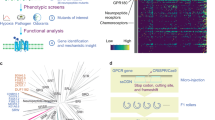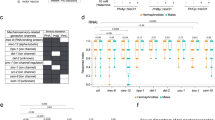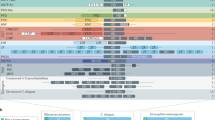Abstract
The extent of gene regulation in cell differentiation is poorly understood. We previously used saturation mutagenesis to identify 18 genes that are needed for the development and function of a single type of sensory neuron—the touch receptor neuron for gentle touch in Caenorhabditis elegans1,2. One of these genes, mec-3, encodes a transcription factor that controls touch receptor differentiation3,4. By culturing and isolating wild-type and mec-3 mutant cells from embryos and applying their amplified RNA to DNA microarrays, here we have identified genes that are known to be expressed in touch receptors, a previously uncloned gene (mec-17) that is needed for maintaining touch receptor differentiation2,5, and more than 50 previously unknown mec-3-dependent genes. These genes are randomly distributed in the genome and under-represented both for genes that are co-expressed in operons and for multiple members of gene families. Using regions 5′ of the start codon of the first 20 genes, we have also identified an over-represented heptanucleotide, AATGCAT, that is needed for the expression of touch receptor genes6.
This is a preview of subscription content, access via your institution
Access options
Subscribe to this journal
Receive 51 print issues and online access
$199.00 per year
only $3.90 per issue
Buy this article
- Purchase on Springer Link
- Instant access to full article PDF
Prices may be subject to local taxes which are calculated during checkout



Similar content being viewed by others
References
Chalfie, M. & Sulston, J. Developmental genetics of the mechanosensory neurons of Caenorhabditis elegans. Dev. Biol. 82, 358–370 (1981)
Chalfie, M. & Au, M. Genetic control of differentiation of the Caenorhabditis elegans touch receptor neurons. Science 243, 1027–1033 (1989)
Way, J. C. & Chalfie, M. mec-3, a homeobox-containing gene that specifies differentiation of the touch receptor neurons in C. elegans. Cell 54, 5–16 (1988)
Way, J. C. & Chalfie, M. The mec-3 gene of Caenorhabditis elegans requires its own product for maintained expression and is expressed in three neuronal cell types. Genes Dev. 3, 1823–1833 (1989)
Mitani, S., Du, H., Hall, D. H., Driscoll, M. & Chalfie, M. Combinatorial control of touch receptor neuron expression in Caenorhabditis elegans. Development 119, 773–783 (1993)
Xue, D., Finney, M., Ruvkun, G. & Chalfie, M. Regulation of the mec-3 gene by the C. elegans homeoproteins UNC-86 and MEC-3. EMBO J. 11, 4969–4979 (1992)
Savage, C. et al. mec-7 is a β-tubulin gene required for the production of 15- protofilament microtubules in Caenorhabditis elegans. Genes Dev. 3, 870–881 (1989)
Gu, G., Caldwell, G. A. & Chalfie, M. Genetic interactions affecting touch sensitivity in Caenorhabditis elegans. Proc. Natl Acad. Sci. USA 93, 6577–6582 (1996)
Jiang, M. et al. Genome-wide analysis of developmental and sex-regulated gene expression profiles in Caenorhabditis elegans. Proc. Natl Acad. Sci. USA 98, 218–223 (2001)
Fukushige, T. et al. MEC-12, an α-tubulin required for touch sensitivity in C. elegans. J. Cell Sci. 112, 395–403 (1999)
Xue, D., Tu, Y. & Chalfie, M. Cooperative interactions between the Caenorhabditis elegans homeoproteins UNC-86 and MEC-3. Science 261, 1324–1328 (1993)
Duggan, A., Ma, C. & Chalfie, M. Regulation of touch receptor differentiation by the Caenorhabditis elegans mec-3 and unc-86 genes. Development 125, 4107–4119 (1998)
Van Helden, J., Andre, B. & Collado-Vides, J. A website for the computational analysis of yeast regulatory sequences. Yeast 16, 177–187 (2000)
Blumenthal, T. et al. A global analysis of Caenorhabditis elegans operons. Nature 417, 851–854 (2002)
Huang, M. & Chalfie, M. Gene interactions affecting mechanosensory transduction in Caenorhabditis elegans. Nature 367, 467–470 (1994)
Barnes, T. M., Jin, Y., Horvitz, H. R., Ruvkun, G. & Hekimi, S. The Caenorhabditis elegans behavioural gene unc-24 encodes a novel bipartite protein similar to both erythrocyte band 7.2 (stomatin) and nonspecific lipid transfer protein. J. Neurochem. 67, 46–57 (1996)
Treinin, M. & Chalfie, M. A mutated acetylcholine receptor subunit causes neuronal degeneration in C. elegans. Neuron 14, 871–877 (1995)
Treinin, M., Gillo, B., Liebman, L. & Chalfie, M. Two functionally dependent acetylcholine subunits are encoded in a single Caenorhabditis elegans operon. Proc. Natl Acad. Sci. USA 95, 15492–15495 (1998)
Rubin, G. M. et al. Comparative genomics of the eukaryotes. Science 287, 2204–2215 (2000)
Chalfie, M. & Thomson, J. N. Structural and functional diversity in the neuronal microtubules of Caenorhabditis elegans. J. Cell Biol. 93, 15–23 (1982)
Liang, P. & MacRae, T. H. Molecular chaperones and the cytoskeleton. J. Cell Sci. 110, 1431–1440 (1997)
Lockhart, D. J. & Winzeler, E. A. Genomics, gene expression and DNA arrays. Nature 405, 827–836 (2000)
Reinke, V. et al. A global profile of germline gene expression in C. elegans. Mol. Cell. 6, 605–616 (2000)
Hill, A. A., Hunter, C. P., Tsung, B. T., Tucker-Kellogg, G. & Brown, E. L. Genomic analysis of gene expression in C. elegans. Science 290, 809–812 (2000)
Eberwine, J. et al. Analysis of gene expression in single live neurons. Proc. Natl Acad. Sci. USA 89, 3010–3014 (1992)
Pfaffl, M. W. A new mathematical model for relative quantification in real-time RT–PCR. Nucleic Acids Res. 29, E45–E45 (2001)
Bailey, T. L. & Elkan, C. Fitting a mixture model by expectation maximization to discover motifs in biopolymers. Proc. Int. Conf. Intell. Syst. Mol. Biol. 2, 28–36 (1994)
Mello, C. C., Kramer, J. M., Stinchcomb, D. & Ambros, V. Efficient gene transfer in C. elegans: extrachromosomal maintenance and integration of transforming sequences. EMBO J. 10, 3959–3970 (1991)
Huang, L. S., Tzou, P. & Sternberg, P. W. The lin-15 locus encodes two negative regulators of Caenorhabditis elegans vulval development. Mol. Biol. Cell 5, 395–411 (1994)
Han, M. & Sternberg, P. W. Analysis of dominant-negative mutations of the Caenorhabditis elegans let-60 ras gene. Genes Dev. 5, 2188–2198 (1991)
Acknowledgements
We thank X. Chen for help with analysis of the microarray data; M. Goodman for constructing the integrated mec-18::gfp strain; B. Tycko for the LightCycler; and E. Schwarz, J. Wang and J. Eberwine for discussion. This work was supported by a grant from the National Center for Research Resources to S.K.K. and a grant from the National Institutes of Health to M.C.
Author information
Authors and Affiliations
Corresponding author
Ethics declarations
Competing interests
The authors declare that they have no competing financial interests.
Supplementary information
Rights and permissions
About this article
Cite this article
Zhang, Y., Ma, C., Delohery, T. et al. Identification of genes expressed in C. elegans touch receptor neurons. Nature 418, 331–335 (2002). https://doi.org/10.1038/nature00891
Received:
Accepted:
Issue Date:
DOI: https://doi.org/10.1038/nature00891
This article is cited by
-
Synaptic branch stability is mediated by non-enzymatic functions of MEC-17/αTAT1 and ATAT-2
Scientific Reports (2022)
-
Homeobox genes and the specification of neuronal identity
Nature Reviews Neuroscience (2021)
-
HSF-1 displays nuclear stress body formation in multiple tissues in Caenorhabditis elegans upon stress and following the transition to adulthood
Cell Stress and Chaperones (2021)
-
Role of tubulin acetylation in cellular functions and diseases
Medical Molecular Morphology (2020)
-
Tubulin acetylation: responsible enzymes, biological functions and human diseases
Cellular and Molecular Life Sciences (2015)
Comments
By submitting a comment you agree to abide by our Terms and Community Guidelines. If you find something abusive or that does not comply with our terms or guidelines please flag it as inappropriate.



